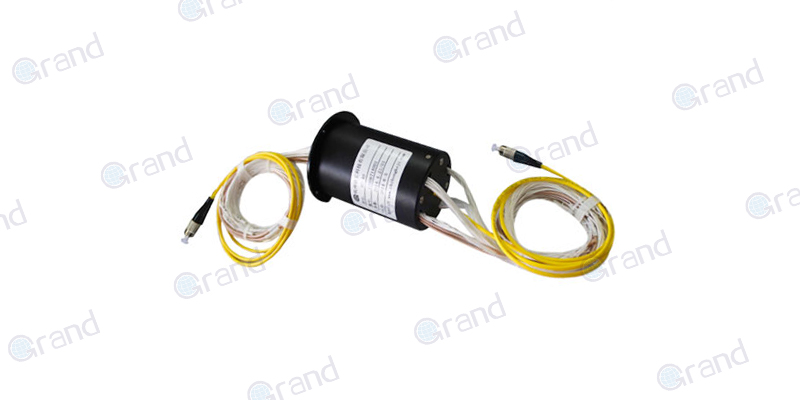Stepping into the world of optical engineering, let’s delve into the comprehensive understanding of optical hollow Shaft Slip Rings. By definition, these are devices that enable the transmission of optical signals across a rotating interface. Essentially, these units provide a slip-free connection to perform continuous transmission of power and data signals while parts of a machine rotate around the shaft.
The importance of these innovative devices cannot be overstressed. Optronic Hollow Shaft Slip Rings offer unique benefits, which include high-speed transmission, low signal attenuation, and strong resistance to electromagnetic interference. They eliminate mechanical friction between stationary and rotating parts, increasing the operational lifespan and reducing maintenance effort and cost. This makes them essential in industries that require data transmission in high-precision devices or under harsh environmental conditions.
Introduction to Optronic Hollow Shaft Slip Rings
Recent advancements and innovations in the field of optical engineering have further unlocked the true potential of optical hollow Shaft Slip Rings. With cutting-edge technology, these slip rings now come with advanced features like modularity, scalability, and hybrid transmission options. The integration of fiber optic rotary joints (FORJs) and the implementation of advanced materials reflect recent strides in enhancing their functionality and efficiency. Researchers are exploring ways to increase their signal transfer rate while reducing installation and maintenance costs, in the quest for engineering excellence.
Seamlessly merging function and form, these advancements have carved a niche for Optronic Hollow Shaft Slip Rings in industries that rely heavily on continuous and high-quality data transmission. Recognizing and truly understanding the role of these slip rings facilitates a better grasp of the fast-paced innovation and progress happening within the world of optical and mechanical engineering.
Optronic Hollow Shaft Slip Rings: Applications and Industries
Exploring the versatility and far-reaching applicability of the Optronic Hollow Shaft Slip Rings, we highlight how these devices are essential across various sectors, revolutionizing their operations.
In the Aerospace and defense industry, reliable and uninterrupted data communication is the lifeline of many critical operations. These range from missile guidance systems to flight control apparatus and telecommunications. Optronic Hollow Shaft Slip Rings offer reliable and high-speed data transfer in these systems, bringing about a revolutionary change in how mission-critical information is handled.

The Wind Energy sector is another key area where these slip rings have a significant impact. In wind turbines, these devices form an essential part of the mechanism, transmitting power and data signals from the rotating nacelle to the still tower base. Their resistance to harsh environmental conditions and high-speed data transfer capabilities have made them a perfect fit for this industry.

In the realm of Robotics, precise control and coordination are fundamental for efficient functioning. Robotic arms, unmanned ground vehicles, and even robotic surgery systems rely on Optronic Hollow Shaft Slip Rings for uninterrupted, high-speed data and power transfer, enhancing their reliability and precision.

The Medical Equipment industry is another critical sector that relies on these slip rings. In diagnostic machines like MRI or CT scanners, these devices ensure smooth, continuous rotation and transmission of high-resolution imaging data. The use of Optronic Hollow Shaft Slip Rings not only ensures high image quality but also enhances the lifespan and safety of these machines.

In Packaging and Automation Systems, these slip rings play a crucial role in assembly lines and automated packaging units. These systems require continuous, uninterrupted operation, with rotating parts often involved for tasks like sealing, labeling, or stacking. Here, the slip rings ensure power and data signals are reliably transferred, supporting streamlined operations.

Finally, in Satellite Communications, these slip rings are essential for stable and efficient ground station operations. They facilitate high-speed and reliable data transfer from the rotating satellite dish to the stationary control units, ensuring optimal communication with orbiting satellites.
Thus, across an array of industries, Optronic Hollow Shaft Slip Rings provide critical functionality, enabling efficient operations, high performance, and a step forward toward a technologically advanced future.
Optronic Hollow Shaft Slip Rings: Components and Working Principle
Diving deeper into the world of Optronic Hollow Shaft Slip Rings, we’ll understand their structure, components, the types of signals they transmit, and their basic working principles.
The structure and components of these slip rings are a marvel of engineering. At the heart of the system are optoelectronic integrated circuits that convert electrical signals to optical ones and vice versa. Surrounding these circuits are optical fibers, carefully positioned within the ring to enable seamless data transmission. Rotating parts of these slip rings, often called brushes, are usually metal-alloy contacts or optical channels that facilitate the transmission. Bearings ensure the smooth rotation of these brushes. The housing, often made of metal or robust plastic, protects the internal components from environmental factors and mechanical stress.
Understanding the types of signal transmissions is key to recognizing the versatility of an Optronic Hollow Shaft Slip Ring. Primarily, optical signal transmission, which involves data transmitted via light signals through optical fibers. Electrical transmission, on the other hand, involves traditional metal brushes and rings to transmit electrical signals. Hybrid transmission combines both electrical and optical transmission techniques, allowing for the transmission of both power and high-speed data.
The working principle behind these units involves two basic concepts – the rotary joint and fiber optic communication. Like a traditional rotary joint, the slip ring allows for rotation between two interconnected parts without tangling the connecting wires. However, the key difference lies in the optic fibers’ application. These fibers act as conduits for light signals, allowing data transmission with low loss and minimal interference. This principle ensures a consistent, high-speed, and robust connection, irrespective of the rotation and environmental conditions, offering unique opportunities across various applications and industries.
Thus, an in-depth understanding of the Optronic Hollow Shaft Slip Rings’ components and working principles propels us into the intricate blend of optical and mechanical engineering that these devices embody.

Optronic Hollow Shaft Slip Rings: Key Performance Parameters
To appreciate the true potential and capabilities of Optronic Hollow Shaft Slip Rings, it is essential to understand the key performance parameters that define their efficiency and applicability across various industries.
The rotational speed is one such parameter that influences their usability. Rotational speed, measured in revolutions per minute (RPM), reflects the operating frequency of the slip ring. Higher RPM enables faster rotation and enhances overall performance, making these devices suitable for high-speed systems and ensuring data and power transmission remain flawless.
Transmission signal types play a significant role in determining the purpose of the slip ring in any given machinery. These devices can accommodate various signal types, including video, control, and data signals. For example, video signals are used in surveillance systems, control signals in robotics for coordination, and data signals in telecommunication systems for data exchange over large distances.
The number of channels is another essential aspect to consider when evaluating an Optronic Hollow Shaft Slip Ring. Depending on the complexity and requirements of the system, each slip ring can have varying amounts of channels to transmit different types of signals. The more channels a slip ring possesses, the more data and power signals can be transferred simultaneously.
Signal quality is a critical parameter when assessing the efficiency of these slip rings. Signal attenuation, which comprises the loss of signal strength during transmission, should be minimal to ensure efficient data transfer. Also, crosstalk, or unwanted signal interference from adjacent channels, should be minimized to prevent distortion and signal degradation.
Transmission rate and distance are crucial factors influencing the applicability and performance of these devices. Higher transmission rates enable these slip rings to transfer larger amounts of data concurrently, suitable for high-capacity systems like CT scanners and satellite communication. The transmission distance is the range across which signals can be transmitted without significant attenuation or loss of integrity.
Finally, environmental factors require careful consideration as they can influence the slip ring’s performance. These factors include temperature, humidity, and vibration, reflecting the device’s resilience under different operational conditions. Efficient Optronic Hollow Shaft Slip Rings should be able to perform optimally under various environmental conditions and withstand physical stress.
Understanding these key performance parameters and their interplay in the overall performance of Optronic Hollow Shaft Slip Rings provides a clearer picture of their capabilities and scope within the vast array of industries that utilize them.
Optronic Hollow Shaft Slip Rings: Selection Considerations
When choosing an Optronic Hollow Shaft Slip Ring, several pivotal factors come into play that affect their efficacy in defined scenarios. Below, we delineate these selection considerations, emphasizing their importance in making an informed decision.
Application requirements form the cornerstone of the selection process. They provide a benchmark for determining the type and specifications of the slip ring to be used. Requirements could be based on factors like the type of machinery, operational speed, the data or power to be transmitted, and the environmental conditions the device will be exposed to.
The hollow shaft diameter is another crucial determinant. The diameter of the shaft refers to the size of the central aperture or hole through which other components can pass. The choice of this diameter depends on the particular application of the slip ring. For example, larger diameters might be needed for applications where cabling or other components need to be run through the center, such as in wind turbines or robotics.
The chosen slip ring must support the required transmission signal types and channels. The nature of data (video, control, data) to be transmitted and the number of channels needed, based on the system’s complexity, influence the type of slip ring to be selected. Needs could vary from simple single-channel devices to quite intricate multi-channel variants.
In the context of performance parameters, considerations like rotational speed, signal quality, transmission rate and distance, and resistance to environmental factors play a significant role. Higher specifications often translate to better performance but could also mean a higher cost.
Material and construction of the slip ring is another critical factor. The materials used for construction (like metals for rings and brushes, or plastic for housing) affect the device’s longevity and performance. Also, the design and construction should be such that they alleviate possible mechanical stress, ensure smooth rotation, and provide easy maintenance.
Finally, price and budget significantly influence the choice of slip rings. It’s a delicate art of balancing affordability and the necessity for high-performance specifications. Although higher-end variants may offer superior performance, budget constraints might require a cost-effective yet reliable choice.
In essence, selection considerations are a blend of functional requirements and financial feasibility, thereby underlining the need for careful evaluation of the application’s requirements and the slip ring’s capabilities before making a decision.
Optronic Hollow Shaft Slip Rings: Installation, Maintenance, and Troubleshooting
To ensure the prolonged life and optimal performance of Optronic Hollow Shaft Slip Rings, understanding how they are correctly installed, regularly maintained, and effectively troubleshot becomes essential. Let’s delve into the details of these crucial aspects.
Proper installation procedures lay a solid foundation for achieving smooth functioning and a long lifespan of the slip rings. The first step is identifying the right location where the slip ring should be mounted – a spot offering minimal exposure to harsh environmental conditions and undue mechanical stress. The hollow shaft diameter should match with the assembly it is to be joined with, ensuring a snug fit. Once mounted, carefully connect the optical and electrical channels as per the labeled coding. Proper installation promotes increased device longevity and optimal performance.
Once installed, routine maintenance and inspection are vital to ensure the slip ring’s continued performance. Periodic checks for signs of wear and tear on the brushes, rings, and other components are required. For example, the housing should be checked for any sign of damage that might compromise the internal components’ protection. The bearings and brushes’ continued smooth operation should be confirmed, and any dust accumulation on the optical channels should be carefully cleaned to prevent data transmission interruptions.
However, even with meticulous maintenance, common issues can arise that require troubleshooting. Signal interruptions might occur due to worn-out brushes or misaligned optical channels. In such cases, visually inspecting the slip ring for noticeable damages or misalignment is the first troubleshooting step. Sometimes, harsh environmental conditions can cause issues; for instance, an overly humid environment can cause condensation to build up on the optical fibers, disrupting the signal. Therefore, adjusting the environmental conditions, like temperature or humidity, might resolve the problem.
To summarize, the accurate installation, diligent maintenance, and efficient troubleshooting of Optronic Hollow Shaft Slip Rings can significantly enhance their lifespan and performance. Each of these steps, when executed correctly, ensures the optimum utilization of these devices, maintaining their pivotal role in innumerable applications across different industries.
Optronic Hollow Shaft Slip Rings: Pros and Cons
In order to evaluate the use and applicability of Optronic Hollow Shaft Slip Rings, it is important to consider their advantages and drawbacks, as well as compare them with traditional slip rings. Let’s examine these factors more closely.
Advantages of Optronic Hollow Shaft Slip Rings
- Enhanced signal quality: With the use of optic fibers, these slip rings can transmit data with minimal loss, low attenuation, and reduced crosstalk, ensuring high signal integrity and quality.
- Higher transmission rates and distances: The implementation of optical technology enables longer-distance transmissions and higher data rates, making it suitable for applications that require high throughput, like video and sensor data.
- Minimal electromagnetic interference: Optronic slip rings experience little to no electromagnetic interference due to the optical nature of their transmission, which allows them to operate efficiently even in environments with high electrical noise.
- Greater flexibility: The hollow shaft allows for additional pass-throughs of cables or other components, providing flexibility and compactness in design, especially in applications with limited space.
- The broad range of applications: The versatility of these slip rings enables their use in multiple industries, from surveillance systems and robotics to wind turbines and satellite communication.
Limitations and Drawbacks
- Higher costs: The integration of optical technology often results in higher costs compared to traditional slip rings, making them less budget-friendly for some applications.
- Complexity: The use of optic fibers requires more intricate installation and maintenance procedures, necessitating a higher understanding of optical systems for proper upkeep.
- Sensitivity to environmental factors: Optical fibers can be vulnerable to environmental conditions like temperature and humidity, which might mandate additional protective measures and more stringent maintenance routines.
Comparing with Traditional Slip Rings
- Signal quality: Traditional slip rings experience more electrical noise and interference, resulting in reduced signal quality and transmission distance compared to their optronic counterparts.
- Wear and maintenance: Traditional slip rings that use brushes and metal contacts can experience more wear and tear, requiring more frequent maintenance to ensure optimal performance.
- Versatility: Optronic slip rings are often more versatile due to their ability to transmit both optical and electrical signals at high rates and distances. Additionally, the hollow shaft design provides flexibility in systems construction.
In conclusion, Optronic Hollow Shaft Slip Rings offer numerous advantages, like enhanced signal quality and broad application prospects. However, their higher costs and sensitivity to environmental factors may present certain challenges. Understanding these pros and cons and evaluating them based on specific scenarios helps make informed decisions when selecting and implementing these highly versatile components.
Optronic Hollow Shaft Slip Rings: Top Manufacturers and Suppliers
Choosing a reputable manufacturer or supplier can have a significant bearing on the quality of your slip rings. It’s advisable to perform comprehensive research and evaluate the quality of products before making the purchase.
| No. | Manufacturer | Website |
|---|---|---|
| 1 | Hangzhou Grand Technology | https://www.grandslipring.com/ |
| 2 | Moog Inc. | https://www.moog.com/ |
| 3 | Stemmann-Technik | https://www.stemmann.com/en/home |
| 4 | Schleifring | https://www.schleifring.com/ |
Hangzhou Grand Technology

Hangzhou Grand Technology Co., Ltd. started as a special slip ring manufacturer in 2011. Grown into slip rings, rotary joints, and slip ring assembly experts of today with 6,000 square meter manufacture complex.
Obtained ISO9001, Rosh, CE, and GJB9001B certificates a number of slip rings, rotary joint patents, and proud of our products can meet military grade. Collaborated with universities, institutes, and renowned factories across Asia and Europe including Panasonic, SIEMENS, CSIC, SAMSUNG, HUAWEI, etc.
Moog Inc.
Moog is a leading supplier of high-performance slip rings for various industries, including aerospace. Among their offerings, Moog’s SR Series Slip Rings are designed for the demanding environments of helicopters, excelling in performance, reliability, and customization potential.
Stemmann-Technik
Stemmann-Technik, a part of the Conductix-Wampfler Group, offers a broad range of slip rings, including solutions for helicopters. Their Livietta Slip Ring Assemblies are designed explicitly for harsh and demanding environments in the aviation sector, providing reliable signal and power transmission.
Schleifring
Schleifring is a well-known manufacturer of electromechanical systems, including slip rings customized for various industries. Their Aircraft Slip Rings cater specifically to helicopters, offering robust performance, low wear, and high reliability to meet the challenges of aviation applications.
In summary, the helicopter slip rings market is shaped by multiple players, factors, and technological advancements. Key manufacturers and their products play a critical role in addressing industry demands for high-quality, reliable, and customized slip ring solutions.
If you want to know more about other slip ring manufacturers, you can read Top 10 Slip Ring Manufacturers in China, Top 10 Slip Ring Manufacturers In the USA Market 2023, and Top 10 Slip Ring Industry Key Manufacturers 2023
Conclusion
While optronic hollow shaft slip rings have revolutionized data transmission methods with their robustness and versatility, they require a certain degree of technical knowledge for selection, installation, and maintenance. Being abreast with the advancements in this field and understanding its futuristic potential can pave the way for opportunities in various industry applications.
Want to discuss your slip ring needs? Fill out the form and we’ll reach out to you.
FAQs about Optronic Hollow Shaft Slip Rings
Making informed decisions about Optronic Hollow Shaft Slip Rings often comes with queries and concerns. Below, we address some of the most frequently asked questions surrounding these devices, along with expert insights and recommendations, to provide a comprehensive understanding of their operation and application.
Q: What is the application scope of Optronic Hollow Shaft Slip Rings?
A: Optronic Hollow Shaft Slip Rings boast an expansive application scope due to their unique construction and features. They are particularly suited to deployments where high data rates, long-distance transmission, and minimal signal loss are required. Their common applications encompass surveillance systems, robotics, wind turbines, radar systems, and satellite communications.
Q: How do environmental conditions affect these slip rings?
A: Due to the use of optical fibers, these slip rings do have a degree of sensitivity to environmental conditions like temperature and moisture. Extreme variations in these factors may compromise signal quality. However, with proper housing and protective measures, these adverse effects can be curtailed, ensuring the slip rings’ reliable and efficient performance.
Q: What type of signals can these slip rings transmit?
A: These devices excel in transmitting both electrical and optical signals, making them versatile in various applications. They can effectively transmit high-speed data signals, HD video signals, and power signals, often supporting multiple channels for simultaneous signal transmission.
Q: Are Optronic Hollow Shaft Slip Rings costlier than traditional ones?
A: Generally, Optical slip rings are more expensive than traditional slip rings, owing to their advanced features like better signal quality and higher data transmission rates. While being costlier, they also provide more robustness and versatility, proving to be cost-effective in several applications that demand high performance.
Q: What does maintenance entail for these slip rings?
A: Periodic maintenance includes visual inspections for physical damages or misalignments, routine cleaning of optical fibers to eliminate dust or extensive residues, and checking for signs of wear on the rotating parts. Regular maintenance ensures optimal performance and extends the lifespan of the slip rings.
Expert insights recommend that choosing an Optronic Hollow Shaft Slip Ring should align with the specific requirements of your application. A thorough understanding of the device’s capabilities and maintenance needs, along with a careful appraisal of the investment, would aid in optimizing their deployment and realizing their full potential.
In conclusion, Optronic Hollow Shaft Slip Rings, with their advanced features and broad application prospects, is a remarkable innovation. Understanding them thoroughly can lead to efficient utilization, thereby providing a synergic blend of performance and reliability across various industrial domains.
See What We Can Do

